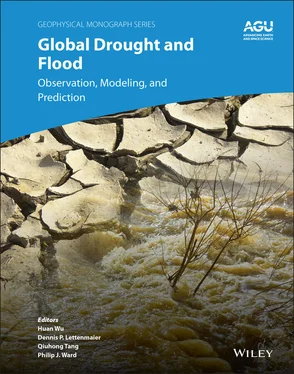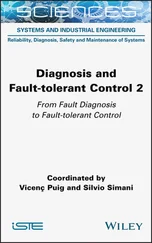(2.10) 
(2.11) 
(2.12) 
while the canopy components are determined as residuals:
(2.13) 
(2.14) 
Hourly E Ciand E Siare integrated to provide the daily total water extractions 〈 E C〉 and 〈 E S〉 used to update the root zone and soil surface moisture pools.
For cloudy pixels, hourly values of latent heat flux are simply estimated from hourly potential evapotranspiration PET iand contemporaneous stress function values, while sensible heat is computed as a residual to the component energy budget:
(2.15) 
(2.16) 
(2.17) 
(2.18) 
2.3.3. Potential Evapotranspiration
The ratio of actual ET to PET (ET/PET) requires the computation of a value for PET. Potential ET is the amount of ET that would occur under optimal conditions over a surface that is at or above field capacity. There are several documented methods that can estimate the value of PET; some are more complicated, such as the PM method, while others, such as the PT approximation, are much simpler. The PT method was chosen to be used within the ALEXI modeling framework because of its relative simplicity and its need for a minimum amount of ancillary data sources. The computation of PET is handled separately between the vegetated and bare soil components of each ALEXI grid cell, and this is done by the partitioning of two equations with respect to the fraction of vegetation cover. Potential canopy transpiration using the PT approximation can be computed by
(2.19) 
Potential soil evaporation is also estimated with a modified PT approximation documented by Tanner and Jury (1976).
(2.20) 
(2.21) 
where τ is the canopy transmission factor, γ is the psychometric constant (0.067 kPa °C ‐1), S is the differential of the saturation vapor pressure versus temperature curve, ϕ sis the solar zenith angle, f cis the fraction of vegetation cover and R nis the net radiation for both soil and canopy components. The value of α cis held constant at 1.3, but the value of α sis a function of the following expressions with a critical value τ critequal to 1.5, when τ is less than the critical value α sis equal to 1. If τ is greater than the critical value, then α scan be computed by
(2.22) 
where α p= 1.3.
Although the ALEXI model estimates the contribution of direct soil evaporation and canopy transpiration separately, partitioned by the percent of vegetation cover, in this study we use only the system (direct soil evaporation + canopy transpiration) actual ET and PET estimates. At present, the system f PETfrom the ALEXI model appears to be more robust than do the component’s f PETvalues, perhaps reflecting errors in the model partitioning of fluxes between the soil and canopy. Qualitative analyses show a large degree of noise in the direct soil evaporation fields, while the canopy transpiration fields tend to exhibit little variability. The total system (direct soil evaporation + canopy transpiration) estimates exhibit far less noise and in essence represent an estimate of a fraction of actual ET to PET. It appears that there is no degradation in quality when using the total system ET fields when comparing the two separate fields of direct soil evaporation and canopy transpiration. The contribution of canopy transpiration compared to that of direct soil evaporation is heavily dependent on several variables: the percent of vegetation cover, vegetation type, and days since the last rainfall. It has been observed that the first few centimeters of the soil profile can dry very quickly after rainfall. Its hydraulic conductivity with the root‐zone is significantly reduced and the two layers become decoupled, and direct soil evaporation ceases (Anderson et al., 2005). The timescale of drying within the root zone is substantially longer than that of the surface layer and plants can continue to transpire at significant rates even through long stretches with a lack of rainfall. The surface layer only represents a small percentage of available water in the soil profile, and even under relatively low percents of vegetation cover, plant transpiration is important and most likely is the dominant source of ET. The total system fraction of actual ET to PET can be expressed as
(2.23) 
where the S and C subscripts represent the contributions from soil evaporation and canopy transpiration, respectively.
Under the assumption that available water within the surface and root‐zone layers is responsible for the partitioning of LE and H , a percent of available water can be retrieved for the complete soil profile in an integrated sense, from a value of f PETcomputed from the ALEXI model flux estimates and an estimate of PET. The scale of the complete integrated soil profile can be described as the depth at which roots extend to provide water to the vegetation. This depth varies as a function of vegetation type, and usually extends in a range of 1–2 m but can extend down to several meters below the surface in extensive forest regions. The combination of the two separate ALEXI model LH estimates is advantageous because it eliminates any error associated with aforementioned assumptions. It can be considered a disadvantage because while it solves for an integrated f AWin the soil profile, it provides no information on the vertical distribution of available water. A wide range of relationships between f PETand f AWcan be found in the literature, while the common similarities between each of the relationships is f PET= 1 at f AW= 1, and f PET= 0 at f AW= 0, a large degree of difference is found between these two endpoints (Anderson et al., 2005).
Читать дальше


























